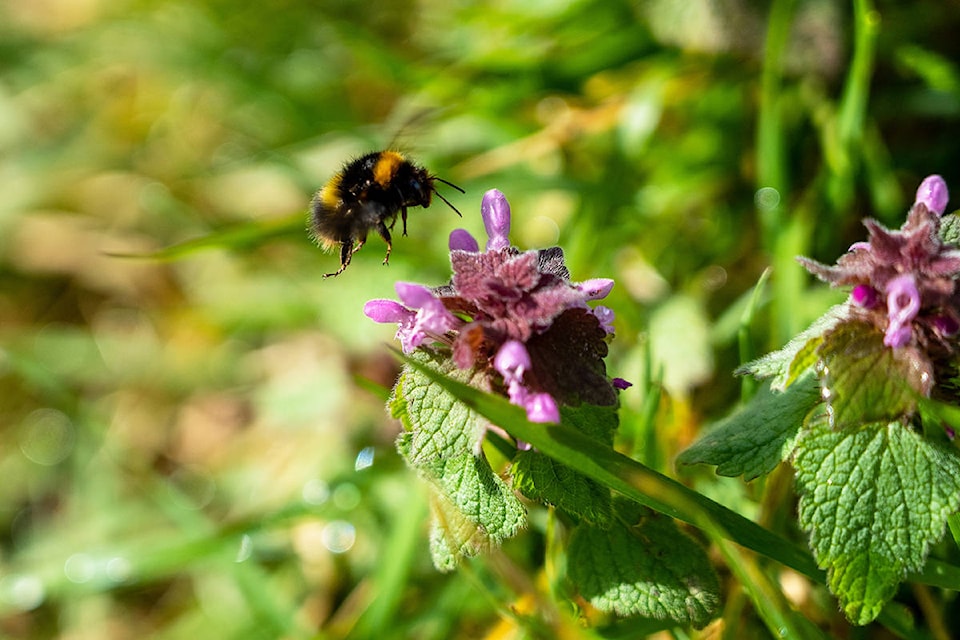With so much sadness: COVID-19, Portapique, Snowbirds, misogyny, hatred, racism, violence and murder, we can’t be faulted for momentary escapes to savor a sunrise, wander the garden, sing with a song sparrow, or dance with bumblebees.
While we can’t avoid adult responsibility to address sadness, neither can we permit sadness to consume us.
We require strength to resist sadness from overwhelming us as we battle its causes.
Strength for me comes from Nature. Song sparrows have been singing and bumblebees have been dancing blissfully indifferent to our personal and social malaises.
The universe is vast. We’re miniscule.
Life has been evolving for three billion years. If fortunate, we sparkle then fade in an immeasurably brief flicker. Surely, within such sputtering transience, we’re entitled to a teaspoon or two of harmless joy.
Spring is a season of joy, rebirth, renewal, a season to strengthen mind and soul. Days lengthen. The landscape warms. It morphs from lifeless brown to fecund green.
In waves, blossoms brighten vistas and fatten pollinators.
It’s no coincidence that Easter, a celebration of rebirth and hope arising from sadness, is encrusted with pagan symbols of fertility and festivity. Easter is fixed in early spring: the first Sunday after the first full moon after the vernal equinox rather than as logic suggests, a definite date to commemorate a hateful, racist, violent murder.
I studied mycology as a part of a major in phytopathology or plant disease.
Although my career has evolved, my interest in fungi persists. I’m frequently invited to present talks or lead walks to search for edible fungi. Spring and fall are the best seasons to forage.
This spring, wandering alone, I collected baskets of morels, pounds of oyster mushrooms, Lazarus mushrooms (able to rise from apparent death), meadow mushrooms, puffballs, and the train wrecker, a relative of Japan’s fabled shiitake.
A friend recently shared images of mushroom people by Heinz Geifus, an early 20th century German illustrator. Geifus created cartoons of common mushrooms personified to parody humans. It’s clear from his art that Geifus loved Nature and loathed pretension.
Geifus led me to Fritz Baumgarten, another early 20th century German illustrator and disciple of Nature. Baumgarten was incredibly prolific. He illustrated and authored hundreds of children’s storybooks.
Many are still in print, translated into multiple languages, published globally. Today we’d describe Baumgarten as ground-zero for a viral pandemic in children’s literature.
Baumgarten created the popular gnome character clad in over-sized shoes, flood pants, hooded jacket, red pointed cap, rosy cheeks, white beard, pin-point eyes and elfin grin. More importantly and more subtly, Baumgarten redefined our relationship with Nature.
Prior to Baumgarten, children’s stories describe Nature as a dark, dangerous place: home to murderous wolfs that eats grandma and cannibalistic witches drooling over Hansel and Gretel.
Our fairy tales have portrayed Nature in mortifying detail for centuries. These tales, passed orally from generation to generation, eventually compiled by the Brothers Grimm, shaped our attitudes towards Nature.
We once steeped our children at an early, highly impressionable age with a deep fear of Nature, of deceitfully vicious, wicked animals, poisonous mushrooms, something to be conquered and controlled without remorse.
Such early lessons became manifest in subsequent adult environmentally destructive behavior.
Subconsciously, children assimilated the lesson that it’s morally just to destroy Nature before Nature devours us.
In contrast, children raised on Baumgarten recognize his gnomes as metaphors for us. In Baumgarten’s books, children learn that we can be caring stewards of Nature.
We can protect insects, birds and our animal relatives.
We can live sustainably in mushroom houses. In harmony with Nature, we can sing with song sparrows and dance with bumblebees. Every spring, we can enjoy a teaspoon or two of harmless joy as we celebrate our connection with Nature in its endless cycle of birth, death, rebirth, and renewal.
Baumgarten’s art is revolutionary.
It reverses the historic paradigm: it’s no longer man versus Nature, but humanity, men and women united in equal non-abusive partnerships, learning to toil and live a simple life, peacefully and joyfully with Nature.
Baumgarten’s message, derided by those who cling to the historic “fear, conquer and destroy Nature” paradigm, is the message we must embrace to vanquish greed, misogyny, hatred, racism, violence, and murder.
Robert M. Macrae, Environmental Technology Instructor, Castlegar.
